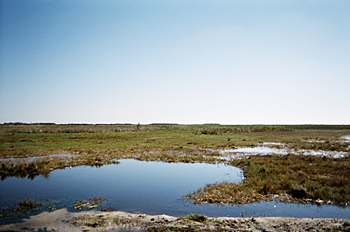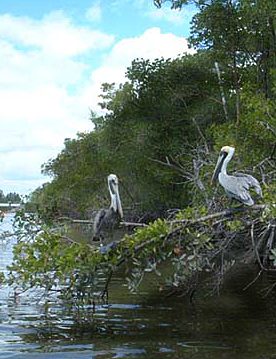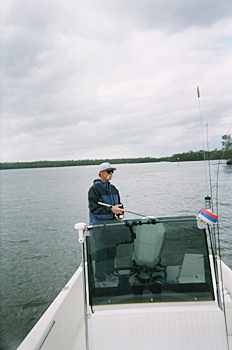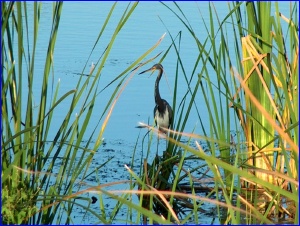

Everglades
National Park
Everglades
National Park has been designated a World Heritage Site, an International Biosphere
Reserve, and a Wetland of International Importance.
Established in 1947,
the Everglades National Park covers 4,000
sq mi in southern Florida extending from Lake Okeechobee southward to Florida
Bay.
Federal Land comprises 1,398,617.13 acres, Non-Federal Land - 461.13 with the
gross total area acres of 1,399,078.26. The Everglades is a
unique ecosystem and is completely dependant upon water flow, making it one of
the largest and most productive estuaries in the world. The Everglades support
more than 350 species of birds and over 1,000 species of plants.
 The
annual average rainfall of more than 60 in. (152 cm) with most falling in the
summer. Big Cypress Swamp, to the northwest, and Lake Okeechobee are the chief
sources of its water.
The
annual average rainfall of more than 60 in. (152 cm) with most falling in the
summer. Big Cypress Swamp, to the northwest, and Lake Okeechobee are the chief
sources of its water.
Everglades National Park is open year round. Highest
visitation is from December through April, and the lowest visitation is May through
November. Walking and canoe trails, boat tours and tram tours are excellent for
viewing wildlife, including alligators and a multitude of tropical and temperate
birds.
Endangered Species in Everglades
National Park:
An
endangered species is a species of plant or animal that, throughout all or a significant
portion of its range, is in danger of extinction. Everglades National  Park
is, or was at one time, home to fifteen endangered species.
Park
is, or was at one time, home to fifteen endangered species.
American
crocodile (Crocodylus acutus)
Green turtle (Chelonia mydas)
Atlantic Ridley
turtle (Lepidochelys kempi)
Atlantic hawksbill turtle (Eretmochelys imbricata)
Atlantic leatherback turtle (Dermochelys coriacea)
Cape Sable seaside
sparrow (Ammodramus maritima mirabilis)
Snail (Everglades) kite (Rostrhamus
sociabilis plumbeus)
Wood stork (Mycteria americana)
West Indian manatee
(Trichechus manatus)
Florida panther (Felis concolor coryi)
Key Largo
wood rat (Neotoma floridana smalli)
Key Largo cotton mouse (Peromyscus gossypinus
allapaticola)
Red-cockaded woodpecker (Picoides borealis)
Schaus swallowtail
butterfly (Papilio aristodemus ponceanus)
Garber's Spurge (Chamaesyce garberi) Everglades
Fishing
Everglades
Fishing
Fishing
abounds in the Everglades. The
unique combination of year-round warm water, brackish rivers and backcountry bays,
mangroves, oyster bars, estuaries, forage, and moving water, makes Southwest Florida
one of the leading fisheries in the World. The
nearshore bays, shallow flats and mangrove shorelines provides endless possibilities
to hook into a trophy Tarpon, Snook, or Redfish. The Everglades National Park
is vast and richly diverse in fish species. With 1.4 million acres in the Park
alone, everglades fishing is very unique. In the same fishing charter, it is possible
to catch bass in the freshwater, snook in the backcountry, tarpon in the rivers,
redfish on the beaches as well as trout on the flats.
Fishing
Regulations in the Everglades
All commercial fishing is prohibited
in Everglades National Park.
Prohibited
Recreational Fishing Gear
Except
for dip nets, cast nets, and landing nets, all other seines and nets are prohibited.
The use and possession of spear guns and spear poles are prohibited.
Fresh
Water Fishing
Freshwater
License
A Florida freshwater fishing license is required to fish in freshwater
or to possess fresh water species.
Bait-
Live or dead fish (including
minnows and shiners) or amphibians, and non-preserved fish eggs or roe, are prohibited.
Digging for bait inside the park is not permitted.
Areas
Closed to Fishing
No fishing
is allowed at the Ernest Coe Visitor Center lakes, Taylor Slough, Royal Palm Visitor
Center area and trails, Chekika Lake and along the Shark Valley Tram Road.
Salt
Water Fishing
Saltwater
License
A Florida saltwater
fishing license is required to fish in saltwater or to possess saltwater species.
Bait
Bait
is not included in bag limits. Saltwater bait: shrimp, minnows, pilchards, pinfish,
mullet, mojarras (shad), or ballyhoo. Bait may be taken with hook and line, dip
net (not wider than 3 feet / 0.9 m), and cast net.
Manatee
Etiquette
Areas frequented
by manatees have been posted. Keep an eye out for manatees. Slow to an idle if
observed, but do not approach or molest.
Lobster
and Queen Conch
The taking
and possession of lobster and queen conch is prohibited.
Recreational
Crabbing
Stone crabs, during
open state season, and blue crabs may be taken by recreational fishermen using
attended gear (for example: star trap, baited line, landing net, etc.). Crabbers
are limited to five (5) traps. Unattended gear, including traps, is prohibited.
Shrimp
Shrimp
may be taken by dip net (not wider than 3 feet / 0.9 m) or cast net, personal
use only, not for sale.
Everglades
Camping

There
are two campgrounds inside the park Flamingo and Long Pine Key.
Long Pine
Key Campground
Located
7 miles / 11 km from the main entrance, just off the main road.
108 drive up
sites for tents and RVs, including one group site.
Close by: Fishing pond,
hiking trails, amphitheater.
Flamingo
Campground
Located at
the end of the main park road in Flamingo.
234 drive in sites, including 55
with a view of the water, four group sites, 64 walk-up sites (20 on the water's
edge).
Close by: observation tower at Eco Pond, hiking trails,canoe trails
and fishing.
Camping is offered year-round at Long Pine Key &Flamingo.Reservations
are strongly recommended at Long Pine Key and Flamingo during peak season from
November 23 to April 18. Call the reservation agent at (800) 365-2267 up to five
months in advance. Both campgrounds are available on a first-come, first-served
basis the rest of the year. Frontcountry fees during peak season are $14 for walk-in
sites, $14 for RV sites, and $28 for group sites. Park campgrounds at Long Pine
Key &Flamingo have drinking water, picnic tables, grills, tent and trailer
pads, and rest rooms. Flamingo has cold-water showers and Flamingo Marina offers
hot showers for $3. RVs are welcome, but there are no hook-ups. Campground stays
are limited to 14 days during the peak season. Checkout time is 11 A.M.  Back
Country Camping in the Everglades
Back
Country Camping in the Everglades
Everglades National Park has three
kinds of backcountry campsites: Chickees, Ground Sites, and Beach Sites.
Backcountry permits are: $10 (1-6 people) $20 (7-12 people) and $30 (more than
13 people).
Chickees are located along interior rivers and bays
where no dry land exists. They are elevated 10 foot x 12 foot / 3 m x 3.7 m wooden
platforms with roofs, usually constructed on open water, well away from mangrove
trees. A narrow walkway leads to a self-contained toilet. You'll need a free-standing
tent, since stakes or nails are not allowed.
Ground sites are mounds
of earth a few feet higher than the surrounding mangroves, located along interior
bays and rivers.
Beach sites are located on coastal shell beaches.
Many beach sites have no toilets.
